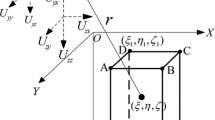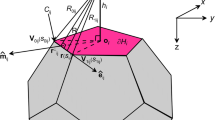Abstract
The direct problem of simple geometrical bodies plays an important role in the gravimetrical processing and modelling tools. We focused on the 3D rectangular prism, which is widely used in such processes. Even though the solution for this body is well known, there are still some issues about it, which are not answered or not answered completely in the available literature, e.g. the presence of the singularities in the source-free points or a continuity of the solutions. We present the singularity-free solution valid for the each position of the calculation point. Next, the analysis of the two basic types of the formulae for the 3D rectangular prism’s gravitational effect is held on. We discuss the ways of their derivation, the validity and the problems connected with them. Later, special attention is paid at the problems with the citation of these two formulae types within the gravimetrical literature.

Similar content being viewed by others
References
Banerjee, B., & Das Gupta, S. P. (1977). Gravitational attraction of a rectangular parallelepiped. Geophysics, 42(5), 1053–1055.
Çavşak, H. (2012). Effective calculation of gravity effects of uniform triangle polyhedral. Studia Geophysica et Geodaetica, 56, 185–195.
D’Urso, M. G. (2014). Analytical computation of gravity effects for polyhedral bodies. Journal of Geodesy, 88, 13–29.
Everest, G. (1830). An account of the measurement of an arc of the meridian between the parallels of 18°3′ and 24°7′. London.
Gradshteyn, I. S., & Ryzhik, I. M. (1962). Table of integrals, series and products. Moscow: State Publishing House of Physical and Mathematical Literature (in Russian).
Haáz, I. B. (1953). Relation between the potential of the attraction of the mass contained in a finite rectangular prism and its first and second derivatives. Geofizikai Kőzlemenyek 2(7) (in Hungarian).
Hamayun, Prutkin, I., & Tenzer, R. (2009). The optimum expression for the gravitational potential of polyhedral bodies having a linearly varying density distribution. Journal of Geodesy, 83, 1163–1170.
Kellogg, D. O. (1929). Foundations of potential theory. Berlin: Springer.
Li, X., & Chouteau, M. (1998). Three-dimensional modeling in all space. Surveys in Geophysics, 19, 339–368.
MacMillan, W. D. (1930). The theory of the potential. New York: McGraw-Hill.
Mader, K. (1951). Das Newtonsche Raumpotential prismatischer Körper und seine Ableitungen bis zur dritten Ordnung. Sonderheft 11 der Österreichischen Zeitschrift für Vermessungswesen. Wien: Österreichischer Verein für Vermessungswesen.
Nagy, D. (1966). The gravitational attraction of a rectangular prism. Geophysics, 31(2), 362–371.
Nagy, D. (1973). A chart for the computation of the gravitational attraction of a right rectangular prism. Pure and Applied Geophysics, 102(1), 5–14.
Nagy, D., Papp, G., & Benedek, J. (2000). The gravitational potential and its derivatives for the prism. Journal of Geodesy, 74, 552–560.
Rektorys, K. (1968). The compendium of the applied mathematics (in Czech). Prague: Publishing House of Technical Literature.
Sorokin, L. V. (1951). Gravimetry and gravimetrical prospecting. Moscow: State Technology Publishing (in Russian).
Werner, R. A. (2017). The solid angle hidden in polyhedron gravitation formulations. Journal of Geodesy, 91, 307–328.
Acknowledgements
This work was supported by the project of the Scientific and Grant Agency of Slovak Republic (VEGA-1/0462/16).
Author information
Authors and Affiliations
Corresponding author
Rights and permissions
About this article
Cite this article
Karcol, R., Pašteka, R. On the Two Different Formulas for the 3D Rectangular Prism Effect in Gravimetry. Pure Appl. Geophys. 176, 257–263 (2019). https://doi.org/10.1007/s00024-018-1966-y
Received:
Revised:
Accepted:
Published:
Issue Date:
DOI: https://doi.org/10.1007/s00024-018-1966-y




